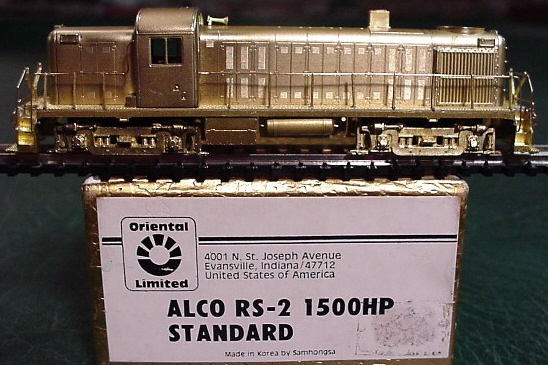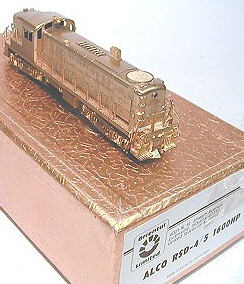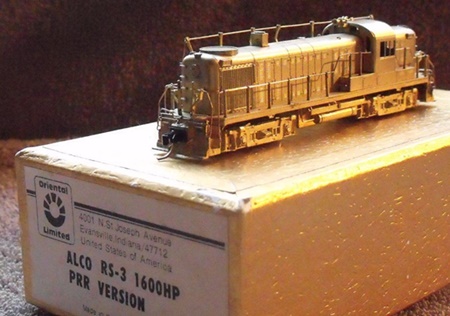
RSC-2

RS-3

RSC-2

RS-3
Introduced: 1983
These models (RS-2, RSC-2, RS-3 and RSD-4/5) all came out at the same time, and as such I'm going to assume they all sport the same basic chassis/mechanism.
Coming out in 1983, these models were some of the first (if not the first) N scale brass locomotives from Samhongsa. Looks-wise, they're fairly typical of Samhongsa brass - IE, very pretty. Also typically, they have no window glazing, couplers or any kind of lighting. Unfortunately, they're also quite disappointing in the performance department - in fact, these are easily some of the worst running brass locos I've yet encountered.
The mechanism design is very typical of 1980s-era Samhongsa. It has a 5-pole motor turning a couple of 3-piece plastic/brass driveshafts. The chassis is brass, with a couple of metal truck towers screwed into it. Most of the truck gearing is metal (more on that in a moment). All axles are geared and all wheels provide pickup (via primitive wheel wipers). Current gets to the motor by way of four separate wires (two per truck). There are no traction tires.
First of all, Samhongsa has a very spotty reputation when it comes to the plastic gears they used in their locomotives. And this run of models in particular seems to have gotten the worst of it. The gears used inside the truck towers on these models are hugely notorious for shrinking (or out-and-out cracking) over time. In fact, I have owned several of these and all of them had bad gears. So, unless you have one that's had its gears replaced somewhere along the line, chances are it doesn't run at all. Yes, NWSL does offer replacements for the truck-tower gears (part #1074-6). Unfortunately, the problems don't end with the bad gears.
Apart from the iffy current collection scheme (IE, the flimsy wheel wipers and all that wiring), there seems to be a basic design flaw in the drivetrain itself. Things don't seem to mesh together very well, and the end result is a lot of excess friction and a whole lot of noise. In fact, these are easily some of the loudest brass locos I've ever run.
I guess if you have one where the wires have held up, the wheel wipers are properly adjusted, and the plastic gears have been replaced, it would probably run OK. They do have the capability of running nice and slow, and the top-end speed is quite reasonable. But, then again, there's all that noise. So, yeah, not much to get excited about here.
To make matters worse, these models are not particularly easy to disassemble. The shell is held to the "chassis" (basically consisting of the walkway/handrail assembly) by four really tiny screws (one on either side of the fuel tank, and one on each end). Once the screws have been removed, you have to then finagle the handrails out of the four tiny holes in the cab. And believe me, getting the shell off is the easy part. Trying to get all those tiny screws screwed back in is something else entirely.
There are several different versions of the RS-2 available - Standard 1500 HP, Turbo-Charged 1600 HP, Modified 1600 HP, and Passenger 1600 HP. Similarly, the RS-3 is available in 1600 HP Canadian, 1600 HP Pennsylvania, 1600 HP Passenger, and 1600 HP Early, Middle and Late versions.
Unlike the "RSD-4" picture above, this one is designated as an "RSD-4/5". The only difference that I can detect is the orientation of the exhaust stack -

Here's the PRR version -

Grade: D
Reviewed: 12/84 Model Railroader ("This particular model, built by Samhongsa in Korea, captures the Pennsy look rather well. All of the parts (etched sheet brass, brass wire, and lost-wax brass castings) fit together well and the soldering is clean and solid. The distinctive PRR Trainphone antenna is a combination of cast-brass stanchions and wire. A double-ended motor sits in the middle of the frame over the fuel tank. Each truck is driven through universals and a gear train that transmits torque to each axle. Contact wipers are built into the top of each truck for electrical pickup. In this way, all eight wheels pick up electrical power for smooth operation. Our sample locomotive ran smoothly throughout its entire speed range, although its starting speed is higher than some other recent imports. It seemed to be a bit tight mechanically, but I could not find any one specific bind. Yet it does run smoothly, and the current draw is well within acceptable limits... The drawbar pull is equivalent to 14 or 15 free-rolling cars on level track. The model's dimensions come quite close to the prototype in all areas. It is a scale 10'-0" wide, 54'-6" long (over the footboards), and 15'-3" high over the horns. Its etched louvers and cast radiator shutters are excellent and every bit as good as any found in the larger scale brass models... This is a fine-quality piece of brass motive power.")